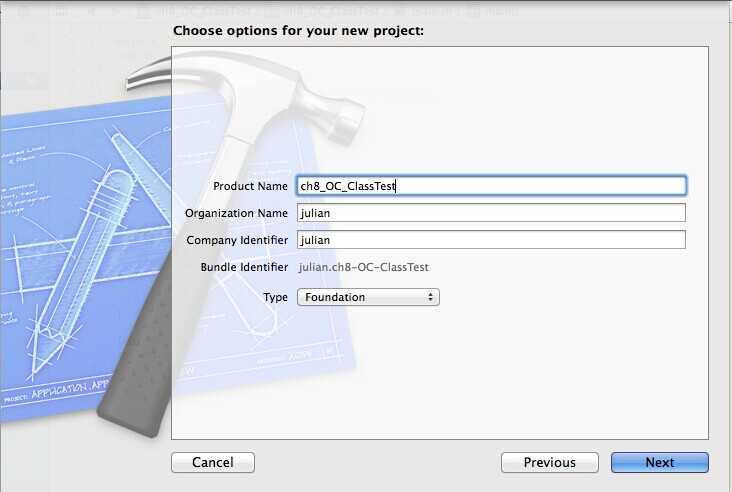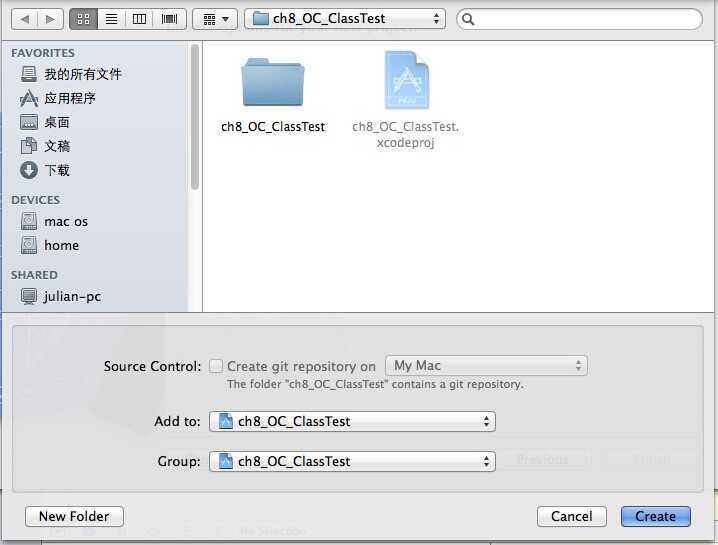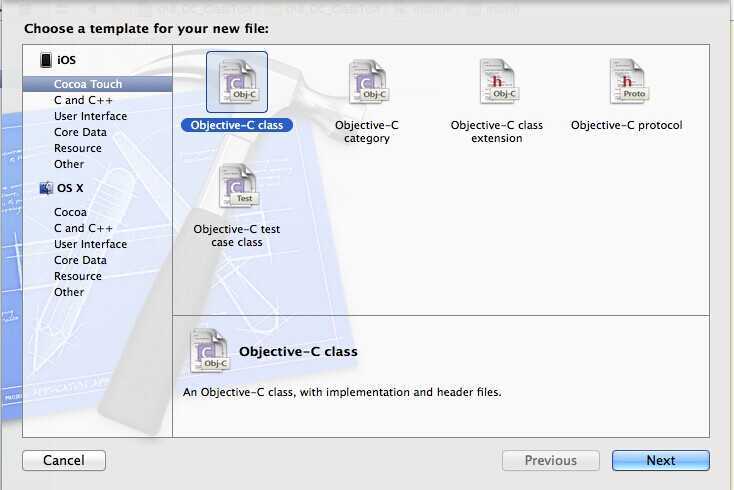标签:des style blog http io ar color sp for
在之前的项目中,我们编程都是直接写在一个main.m文件中。类的main()函数,@interface和@implementation部分都塞进一个文件。这种结构对于小程序和简便应用来说还可以。但是项目文件一多,规模一上去。这样就很不好,既不美观,代码也不好管理。
那么,接下来这篇博文,我们就接着上一节的例子。将他定义和实现的代码分开,每个对象一个类。在Objective-c中,定义的文件写在h文件中,实现的代码写在m文件中。于是,我们先新建一个Command Tools项目。

选择项目文件要保存的地方

然后在新建的项目中依次新建三个类对象Car,Engine,Tire。每个类建好,都会生成两个文件(.h:写定义方法,.m:写实现方法)。

然后在Engine.m中写实现方法:
1 #import "Engine.h" 2 3 @implementation Engine 4 -(NSString *)description 5 { 6 return (@"I am an engine. Vrooom!"); 7 } 8 @end
Tire.m中写实现方法:
1 #import "Tire.h" 2 3 @implementation Tire 4 -(NSString *) description 5 { 6 return (@"I am a tire. I last a while"); 7 } 8 @end
接下来修改Car.h文件,写Car类的定义方法:
1 #import <Foundation/Foundation.h> 2 #import "Engine.h" 3 #import "Tire.h" 4 5 @interface Car : NSObject 6 { 7 Engine *engine; 8 Tire *tires[4]; //四个轮子,定义一个四个数的数组。 9 } 10 -(Engine *) engine; 11 -(void) setEngine:(Engine *) newEngine; 12 -(Tire *) tireAtIndex:(int) index; 13 -(void) setTire:(Tire *) tire atIndex:(int) index; 14 -(void) drive; 15 @end // Car
注意:要先在最上面引用“Engine.h”和“Tire.h”。否则,代码就不能编译通过。
然后是修改Car类的实现方法:
1 #import "Car.h" 2 3 @implementation Car 4 -(void) setEngine:(Engine *) newEngine 5 { 6 engine = newEngine; 7 } 8 9 -(Engine *) engine 10 { 11 return (engine); 12 } 13 14 -(void) setTire:(Tire *) tire 15 atIndex:(int) index 16 { 17 if(index<0 || index>3) 18 { 19 NSLog(@"bad index(%d) in setTire:atIndex", 20 index); 21 exit(1); 22 } 23 tires[index] = tire; 24 } 25 26 -(Tire *) tireAtIndex:(int) index 27 { 28 if(index<0 || index>3) 29 { 30 NSLog(@"bad index(%d)in tireAtIndex:", 31 index); 32 exit(1); 33 } 34 return (tires[index]); 35 } 36 37 -(void) drive{ 38 NSLog(@"%@",engine); 39 NSLog(@"%@",tires[0]); 40 NSLog(@"%@",tires[1]); 41 NSLog(@"%@",tires[2]); 42 NSLog(@"%@",tires[3]); 43 } 44 @end
最后,只要在main主函数的文件中,引用三个类文件的定义文件就可以了,实现的代码不用变:
1 #import <Foundation/Foundation.h> 2 #import "Engine.h" 3 #import "Tire.h" 4 #import "Car.h" 5 6 int main(int argc, const char * argv[]) 7 { 8 Car *car = [Car new]; 9 Engine *engine = [Engine new]; 10 [car setEngine:engine]; 11 for(int i=0;i<4;i++) 12 { 13 Tire *tire = [Tire new]; 14 [car setTire:tire atIndex:i]; 15 } 16 17 [car drive]; 18 return 0; 19 }
项目文件的基本结构,以及运行的结果如图:

由于本篇博文只是简单的将代码结构重新的整理了下,至于功能代码则和上一篇中介绍的完全相同,这边就不再细说了。如果朋友们感兴趣或者有看不懂的,可以查看上一篇博文,或者给我留言。好了,时间不早了,洗洗早点睡吧。
《objective-c基础教程》学习笔记(八)—— 拆分接口和实现
标签:des style blog http io ar color sp for
原文地址:http://www.cnblogs.com/jianglan/p/4141611.html